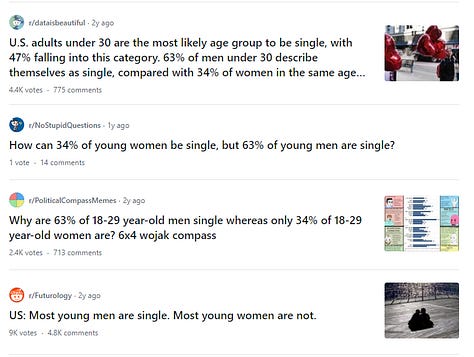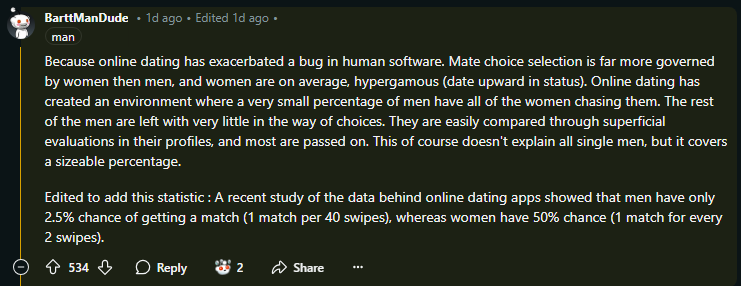Further Confirmation the Pew Singleness Gap is False
There is no massive relationship discrepancy to explain
Perhaps the most widely cited statistic of the past few years came from a Pew report showing that 63% of men but only 34% of women in the 18–29 age bracket reported not being in a committed relationship. This unleashed a tsunami of media coverage and public discourse. You couldn’t miss it.









When people are exposed to this information, they typically react with bemusement, then begin contemplating possible explanations:
Debate over these survey results continues to rage on. The ‘explanation’ that most people seem to have more or less settled on though is: ‘Women think they’re in an exclusive relationship with Chad, but actually…’. This narrative was already picking up steam due to confusion surrounding dating apps, the viral GSS chart on sexual inactivity, and the rising influence of manosphere ideology, so this just amplified it to another level.
I’ve already covered this meme extensively, so I won’t reiterate those points here.
What nobody ever stopped to question was whether the data was even accurate. Because it’s from a reputable source, people just assume there’s no room for error.
Recently, the Survey Center on American Life released data from a survey conducted in August 2023, just over a year after the Pew survey was. The sample size for the 18–29 age bracket was 1,131, larger than Pew’s sample of 883—though this difference was driven solely by male respondents. Both surveys used panels managed by Ipsos.
Once again, the 29% singleness gap fails to materialize in another survey. Instead we see a gap of about 8%, with about 50% of men and 42% of women in this age bracket reporting being single12.
This is what it looks like in a scatterplot. The gap stays steady until it begins to reverse around the mid-30s.
They also asked about sexual activity. Not much ‘hook-up culture’ being participated in here: only 8% in the 18–29 age bracket who weren’t involved in a committed relationship had been sexually active in the past week, or about 15% in the past month, and about 70% hadn’t had sex in the past year3.
Many explanations were proposed for the puzzling 29% discrepancy in the Pew survey, as it seemed too wide to be plausibly explained by age gaps when they’re only a few years on average. These included women foregoing men in favour of lesbian relationships, foregoing younger men in favour of sugar daddies, differing definitions of what constitutes a ‘committed relationship’, and, of course, ‘Chad harems’.
We don’t have to decide between seemingly implausible explanations, however, because the entire debate has been based on a false premise. How is it possible that there are almost twice as many single young men than women? It probably isn’t, which is why it’s not true. It’s remarkable how many words have been wasted on a single outlier result, with no end in sight. Even 1,000 conflicting surveys likely won’t make much difference in our broken information landscape.
They first asked if participants were married, then if they were in any other form of ‘committed relationship’.
It should be noted that the lack of a reversed gap in the 30–49 age bracket doesn’t necessarily mean the 18–29 gap is caused by boomer sugar daddies. This is because there will also be older men pulling women out of the 30–49 dating pool, offsetting the effect. For old people, the singleness gap will of course be largely driven by men dying off sooner.
Though it should probably be said that people who join online panels are less promiscuous on average due to personality differences.














I honestly think the reason why it says half of single 18-29 year olds are virgins is because it was august 2023 which means Covid was recent, and it includes 18-20 year olds and only restricts it to singles, and virgins are more likely to be single
I think the percent of people who are virgins by a certain age should be updated every 5 years.
Honestly I thought it was because the average age difference in a couple is the guy being 2-3 years older. So you've got 18-29 year old women dating 21-32 year old guys, which is a difference that could explain a 25% difference, since the 27-29 year old women, roughly 25% of the women in that age range, would be dating men out of the survey's age range. Add to that that late 20s women are more likely to be in a relationship than younger women, and your gap is explained.